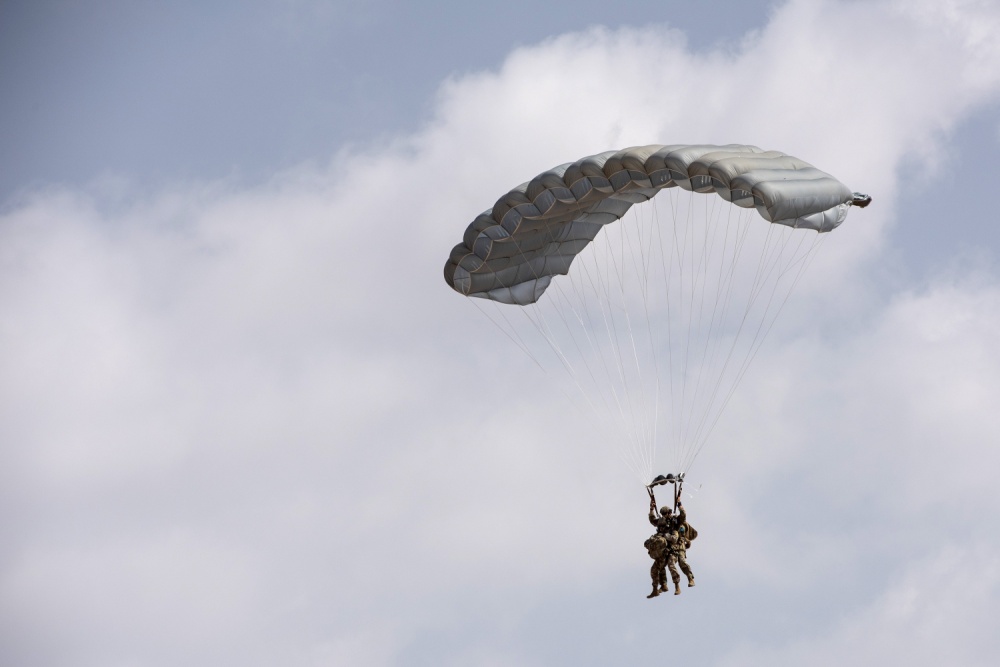 Photo By Master Sgt. Sarah Mattison | U.S. Air Force Pararescuemen from the 82nd Expeditionary Rescue Squadron participate in a high altitude, low-opening tandem free-fall jump to bring in a medical doctor, in Djibouti City, Djibouti, April 24, 2018. The free-fall jump was conducted as part of a joint training exercise. (U.S. Air National Guard photo by Master Sgt. Sarah Mattison)
Photo By Master Sgt. Sarah Mattison | U.S. Air Force Pararescuemen from the 82nd Expeditionary Rescue Squadron participate in a high altitude, low-opening tandem free-fall jump to bring in a medical doctor, in Djibouti City, Djibouti, April 24, 2018. The free-fall jump was conducted as part of a joint training exercise. (U.S. Air National Guard photo by Master Sgt. Sarah Mattison)
DJIBOUTI
04.24.2018
Story by Master Sgt. Sarah Mattison
Combined Joint Task Force - Horn of Africa
DJIBOUTI, Africa - Service members assigned to Combined Joint Task Force-Horn of Africa (CJTF-HOA) and Camp Lemonnier participated in a joint mass-casualty exercise, April 24. This exercise enabled multiple units to work together to tackle complex issues, while securing, treating, extricating and evacuating simulated casualties.
The exercise, which started with a simulated improvised explosive device (IED) blast on a convoy, included twenty-five volunteers that had been moulaged with various simulated injuries requiring triage and treatment. Guardsmen from the Texas Army National Guard’s 3rd Battalion, 144th Infantry Regiment arrived on scene as the quick-reaction force and secured the area. At the same time, pararescuemen (PJs) from the 82nd Expeditionary Rescue Squadron (82nd ERSQ) circled above in a C-130J Super Hercules operated by the 75th Expeditionary Airlift Squadron, preparing to jump to the site below.
“The overall goal is to demonstrate a capability to interoperate with all of these different partners as part of a mass-casualty exercise,” said 1st Lt. Jake, with the 82nd ERSQ. “We can jump the PJs in, establish site security with the site security team and then the PJs can treat and determine who needs the most critical care.”
The PJs also jumped with a couple of tandem passengers, including the tactical air control party (TACP) and a doctor. After hitting the ground, the doctor took over the casualty collection point and began triaging and treating patients, while the TACP maintained airspace deconfliction and surveyed helicopter landing zones to expedite evacuation of the simulated casualties. Simultaneously, the PJs began extricating individuals that were trapped inside of the crushed vehicles.
Staff Sgt. Matthew, who works in material management support for the 82nd ERSQ, volunteered to be one of the simulated casualties.
“I volunteered because I wanted to support an exercise that could potentially be a real world medevac response,” Matthew said. “I think this [training] is important because being in a deployed environment, this could potentially become a real world situation.”
While planning for the exercise was lengthy, it was training that was well worth the time and effort that it took to put together
“Doing this exercise, not only does it demonstrate that we have these capabilities, but it also means that we are training with these capabilities as we go along,” said Jake. “So if this were to happen real word, then we’ve already done training with these guys and agencies before, so it would be easy to put together different pieces of what we’ve already done today.”